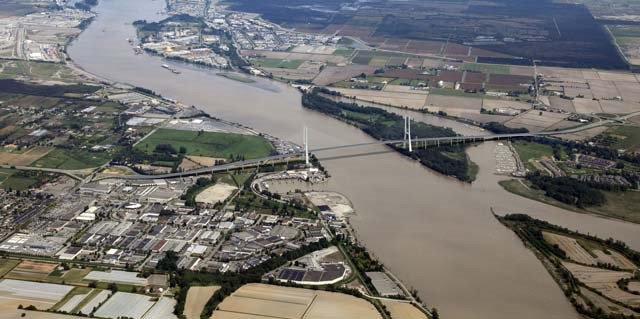‘We are still far from knowing what this project is really about.”
Mayor Malcolm Brodie had plenty of questions, despite the detailed revealing of the proposed $3.5 billion toll bridge to replace the Massey Tunnel.
So it was a shame, and somewhat “unusual,” as described by the mayor, that no elected official from the City of Richmond was invited to Wednesday’s project announcement.
Half of the new, 10-lane (including HOV lanes), 3.5-kilometre span — the biggest in B.C.’s history — will be in Delta, so it was no surprise to see Delta mayor Lois Jackson and Delta North MLA Scott Hamilton appearing alongside the provincial transportation minister, Todd Stone.
Absent from formal proceedings at the project office, ironically in Ironwood, Richmond, was any official from this side of the Fraser River.
“Nobody from the City of Richmond was invited,” Brodie said bluntly. “You’ll have to ask the ministry why.”
The Ministry of Transportation didn’t return the News’ call before press time.
“Far more important than that, though,” said Brodie, “is what they announced and what’s still missing. There are questions that Richmond has been asking all along that still remain unanswered.”
Construction of the new bridge is set to begin in 2017 and finish in 2022. Although the toll rate is still to be determined, Stone said it would be comparable with the Port Mann Bridge pricing, which is $3.15 per crossing.
The project will include an HOV lane in each direction, as well as significant Highway 99 “improvements” at major intersections, such as at Highway 17A in Delta and Steveston and Westminster highways.
And dedicated transit/HOV lanes will be constructed between Bridgeport Road in Richmond and Highway 91 in Delta, as well as a transit-only ramp at Bridgeport Road.
However, Brodie is adamant that, despite Wednesday’s announcement, there are still major pieces of the tunnel replacement jigsaw missing.
“What about the northbound traffic (after the new bridge)? It sometimes goes back to the tunnel from the Oak Street Bridge? There is still going to be a logjam there,” said Brodie.
“Tolling will lead to more congestion on the Alex Fraser, which is going to be horrendous.
“Priorities? How did this become the province’s top project, rather than fixing public transit across the region?”
As far as a toll bridge causing traffic to slide over and further clog the Alex Fraser, Stone pointed to evidence that, despite an initial avoidance to use the newly tolled Port Mann Bridge, drivers eventually returned to the bridge, especially during peak time usage.
At Wednesday’s news conference, the project’s executive director, Geoff Freer, was also asked by the News about the potential loss of farmland on the Richmond side, due to the bridge’s construction.
Freer said there would actually be a “net gain” of farmland, due to highway rights of way going back into the Agricultural Land Reserve.
“What does net gain mean?” questioned Brodie, however. “There’s going to be a major amount of road widening. Tell us what we’re getting and what we’re losing.”
Questions were asked by the media of Port Metro Vancouver’s (PMV) involvement in the project, which was largely absent in the Project Definition Report, revealed Wednesday.
“Is this really a shipping project?” asked Brodie.
“(PMV) has said before there will be more dredging and I would still suggest we are going to see bigger vessels on that river. I’ve no doubt the benefits to the port are more significant (than what’s being portrayed). I’d like to know how much the port is going to put into this.”
In a response to the News’ questions, the port’s vice president of planning and operations, Peter Xotta, said, in regards to helping fund the new bridge, “it is much too early in the process to comment at this time.”
In answer to questions about deeper dredging in the river once the tunnel is decommissioned, Freer explained how it would not be possible unless other objects, such as water and sewer pipes, are removed.
“What we understand, from the port, is that there wont be any big change at all,” added Freer.
Removing portions of the tunnel, said the report, would increase the water draft by less than two metres.
Allan Baydala, PMV’s chief financial officer, has said previously that “while the removal of the tunnel may create greater depth at that point in the river, the amount of dredging required on either side of the former tunnel could be extensive and potentially cost prohibitive…(the tunnel’s)…removal will not have a significant impact on the size of ships…”
The port’s Xotta, however, told the News in a statement that PMV supports the bridge project “because it could allow for new options for using the Fraser River to support Canada’s trade objectives.”
Exactly what those options are, if it’s not larger vessels, wasn’t made clear.
Stone said the ministry is in discussion with the federal government — PMV is generally considered the federal entity — about funding.
“The port is one of the stakeholders and we’ve asked them to be involved, as there will be significant benefits from the movement of goods.”
The new bridge will have vertical clearance similar to that of the Alex Fraser Bridge.
Stone said the project will create 9,000 jobs, mostly in construction. Both Freer and Stone explained how they don’t believe the traffic will be any worse at the Oak Street Bridge, despite concerns that the current bottleneck at the tunnel will simply be passed north on Highway 99.
The report illustrates how, according to government calculations, 59 per cent of the traffic currently flowing north through the tunnel at peak times terminates in Richmond, before even hitting the Oak Street Bridge.
The third phase of public consultation on the project is now underway, through Jan. 28, 2016. More details on how to participate are available at www.masseytunnel.ca.
Traffic through the tunnel will be maintained while the new bridge is under construction.



